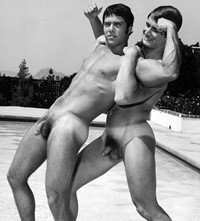Bruce Bellas, AKA Bruce of Los Angeles, is known as the grandfather of physique photography, influencing seminal image-makers like Robert Mapplethorpe and Herb Ritts. Continuing a new series, Miss Rosen looks at the man behind the photographs
- TextMiss Rosen
Tales from another time... In a new series, titled Illicit Histories, Miss Rosen tells the stories of queer art’s pioneers, unpacking the lives and work of people who revolutionised gay erotic imagery – often in defiance of censorship laws.
Hailing from depths of the American heartland, Bruce Bellas (1909–1974) developed a love for photography as he drove through his native Nebraska, photographing the farm boys, athletes, soldiers, and sailors he encountered along the way. Seduced by the medium and the possibilities it allowed, Bellas quit his job as a chemistry teacher and headed west to California in the late 1940s to become a professional photographer.
Adopting the name Bruce of Los Angeles, Bellas became the pioneer of beefcake photography at a time when homosexuality and depictions of full frontal male nudity were illegal. “Homosexuality was something not to talk about in polite company but I think there was a community there, albeit underground,” says gallerist Brian Paul Clamp.
“Bruce of Los Angeles was shooting pictures of handsome young men clothed and unclothed but those prints were never exhibited. They were only exchanged under the table quietly and literally kept in the closets of their owners. It was an exciting time in Hollywood and there were gay people in the industry but it was still a time to be discreet and careful.”
Bruce operated above board in all things, taking great strides to establish himself and his brand of beefcake in an openly antagonistic world. In 1948, he obtained his first California business licence and set to work photographing model Leonard Chambers, who was simultaneously posing for Bob Mizer at AMG Studio. Inspired by the work of photographers like Lon Hanagan, George Platt Lynes, and Herbert List as well as the bodybuilding scene down at Muscle Beach in Venice, Bruce began publishing his work in physique magazines by Joe Weider and others.
“Bodybuilding started to become popular in the early 20th century but it wasn’t until the 40 and 50s that it really gained public recognition through Hollywood films,” says Clamp. “The general public appreciated bodybuilding but it was an open secret that it was appreciated by a homosexual audience as well.”
Bruce rode the wave of beefcake right to the top, photographing the most important men on the physique scene including Steve Reeves, Bob McCune, George Eiferman, Dick DuBois, Irvin ‘Zabo’ Koszewski, and Bud Counts. What set Bruce apart from his contemporaries was his tongue-in-cheek style that effortlessly combined campy humour with sexy wholesomeness.
Whether wearing skimpy “posing straps” or nothing at all, Bruce took great care to orchestrate beautifully lit and classically composed scenes that were imbued with all the glamour and grandeur of Hollywood’s golden age. Ever business-minded, he recognised the growth spurt in physique magazines and decided to throw his hat in the ring. In 1956, Bruce launched the Male Figure magazine, and his hunch paid off. Two years later he relocated to the suburbs of Los Alamitos, and set up a studio in his garage.
“Bruce realised rather than giving his work to other publications, he might as well start his own, but certainly it took bravery and a lot of work in terms of promotion and distribution. At the same time, he was fueling the popularity for his own imagery so he could sell more prints,” Clamp says.
“They were advertised to art students and other avid young bodybuilders but everyone understood there was a huge homosexual audience that was consuming these prints. Bruce didn’t break any laws: he never sent full frontal nudity through the mail. Instead he would pack full steam trunks of his prints and travel to major cities to sell them out of hotel rooms. He understood exactly what he was doing and played it smart as well.”

Bruce of Los Angeles and his beefcake photography served as the perfect counterpoint to Bernard of Hollywood and his fabled cheesecake photos of Marilyn Monroe. Bruce continued to photograph the biggest models of the day including Joe Dallesandro, Steve Wengryn, Mark Nixon, and Brian Idol, successfully avoiding any contretemps with the law or having to hide his identity to live a double life.
“His daily life was his personal life; he wasn’t working a corporate job and I don’t think he had to switch gears as much as other people of the time,” Clamp says. “Bruce enjoyed his work and his models. He was really having fun. I think that says so much about his success as well.”
By 1968, things began to change as the courts revoked their prohibition of full-frontal male nudity in magazines. As hardcore pornography came in vogue, the more innocent pin-up style of Bruce of Los Angeles seemed quaint. Audiences who voraciously consumed physique magazines now had new eye candy to sample and moved on accordingly.
While on vacation in 1974 with Scotty Cunningham, his favourite model, Bruce of Los Angeles died. But his legacy lives on in the works of Robert Mapplethorpe and Herb Ritts. “Bruce is the grandfather of physique photography, the one we think of first and foremost,” Clamp says.
“Ritts was aware of his work and what he had done. He was working in the middle ground between commercial photography and fine art, [using his aesthetics] to sell perfume and clothing. Mapplethorpe is taking the same influences but doing something very different with them. He’s thinking about racial identities, fetishes, and minorities within other minorities. Bruce was able to crack the door and they were able to open it wide for the next generation.”















